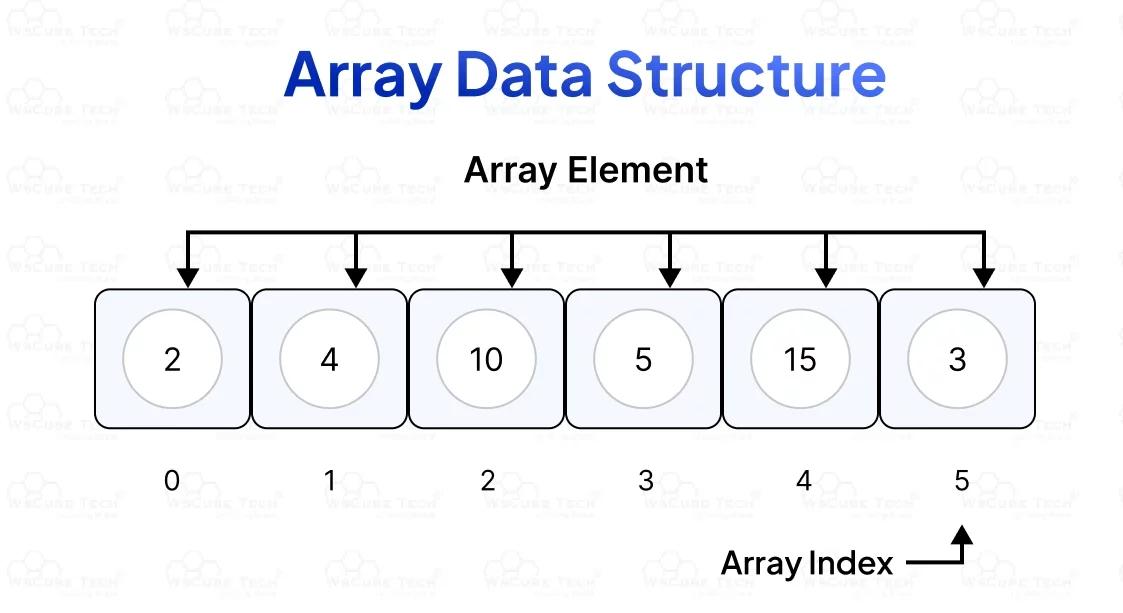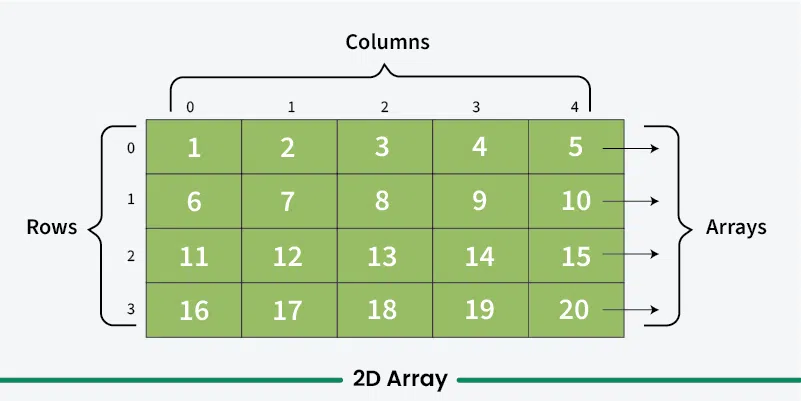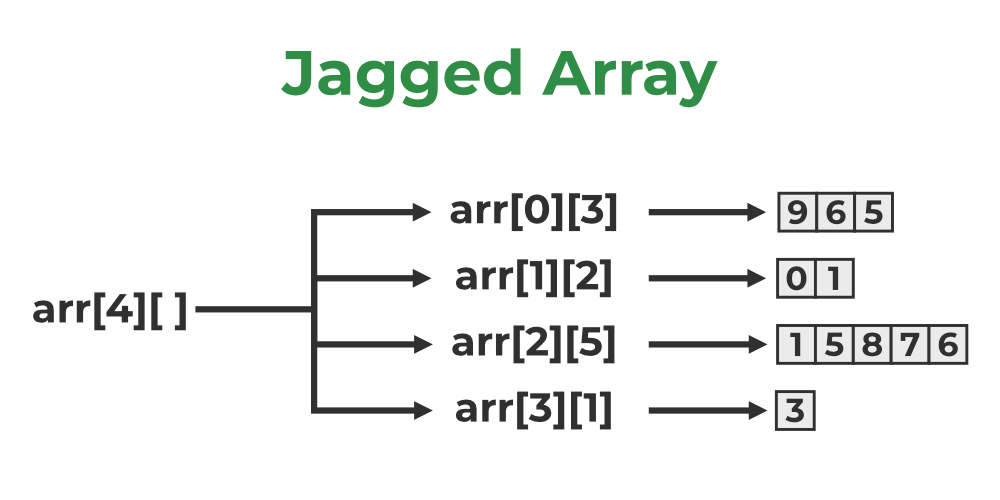What Is an Array? Meaning, Types, and How It’s Used
Table of Contents

You are at a grocery store with a list of 10 items. Rather than throwing the items randomly in the cart, you lined them up in an organised fashion. Now, if someone asks you where the milk is, you could simply point to the second space. This is just like an array when programming.
Arrays are laminated, labelled, and easy-to-access shelves that are organised. They are a fundamental building block of data structures and algorithms used universally, from mobile games storing high scores to large-scale data systems powering search engines. In this post, we will explore what is an array in data structure, and how it is implemented in Java(code).
We will also discuss different types of array in data structure and their applications in various fields, using a real-life example. From the curious newcomer to the person reviewing the concepts of their introduction to DSA arrays, this post will make arrays simpler and relatable with clear examples.
So, What Exactly Is an Array?
In simple terms, an array in data structure is a process that stores a collection of elements, usually of the same type, at contiguous memory locations. Each element has an index that allows it to be accessed very quickly.

*wscubetech.com
An array in data structure can be compared to a row of mailboxes labelled with numbers. If you know the number, you can easily find the proper mailbox to obtain your mail. This is what it means to index an array.
In technical terms:
- Fixed size: You determine the size of the array beforehand.
- Same data type: All elements in the array must be of the same data type (integers, strings, etc.).
- Stored consecutively in memory: The elements are stored side by side in memory.
What is the Importance of an array in data structures in Programming? Arrays aren’t just useful—they’re critical. Here are a few reasons:
- Fast access: You can access any one element using its index directly.
- Space efficient: Arrays store multiple items of the same type compactly.
- A foundational structure for other structures: Arrays are a basis of more complex structures like stacks, queues, heaps and matrices.
- Good for algorithms: Many algorithms (sorting and searching, like binary search, quicksort, etc.) are implemented with arrays.
Understanding an array in data structure helps lay a strong foundation for exploring these advanced structures and algorithms.
Arrays in Different Programming Languages (With Examples)
Let’s now look at how an array in data structure is implemented across various popular programming languages using the same example: storing the ages of students in a classroom.
Python
In Python, arrays are created using lists, which are flexible and easy to use.
python
ages = [14, 16, 15, 14, 16]
print(ages[2]) # Output: 15
Python lets you access any element using its index (starting at 0). Here, ages[2] gives the third age in the list.
C
When you ask what an array is in C, it refers to a statically typed structure defined with a fixed size and type.
c
#include <stdio.h>
int main() {
int ages[] = {14, 16, 15, 14, 16};
printf(“Third age: %d\n”, ages[2]);
return 0;
}
C arrays are fast but rigid; you can’t resize them later. This characteristic is central to understanding the types of array in C.
C++
C++ builds on C’s array capabilities and introduces more flexibility using the STL vector.
cpp
#include <iostream>
#include <vector>
int main() {
std::vector<int> ages = {14, 16, 15, 14, 16};
std::cout << “Third age: ” << ages[2] << std::endl;
return 0;
}
Here, vector allows dynamic resizing and better memory management.
Java
Java arrays are strictly typed, and their size is fixed once initialised.
java
public class Main {
public static void main(String[] args) {
int[] ages = {14, 16, 15, 14, 16};
System. out.println(“Third age: ” + ages[2]);
}
}
Java provides strong type safety and bounds checking, preventing out-of-range errors.
JavaScript
JavaScript arrays are super flexible—you can mix types, add or remove items on the fly.
Javascript
let ages = [14, 16, 15, 14, 16];
console.log(“Third age:”, ages[2]);
JS arrays can contain numbers, strings, even objects; all in the same list.
Understanding Different Types of Arrays
Let’s explore the three most common types of arrays in data structure types—one-dimensional arrays, multi-dimensional arrays, and jagged arrays, with real-life analogies, original examples, and a sprinkle of practical insights.
1. One-Dimensional Arrays (1D Arrays)
A one-dimensional array is the simplest form of types of array in data structure. These arrays are usually indexed from 0 to n-1, where ‘n’ is the size of the array in data structure. Each of the items is stored in consecutive memory locations that are accessed using an index, like an array index.
In learning an array in data structure, 1D arrays are the starting point. They are often used for storing scores, daily logs, or names.
Use Cases:
- To store a list of names, ages, or scores
- Tracking steps taken every day for a week
- To create simple buffers or queues
Representation of a One-dimensional array in data structure
Example of a One-dimensional array in Java:
public class StudyHours {
public static void main(String[] args) {
int[] hoursStudied = {2, 3, 1, 4, 2, 5, 3}; // Hours for each day of the week
System.out.println(“Hours studied on Thursday: ” + hoursStudied[3]);
}
}
Output: Hours studied on Thursday: 4
Code Explanation: The array in the data structure hoursStudied stores study hours from Monday (index 0) to Sunday (index 6).
hoursStudied[3] returns the value for Thursday, which is 4 hours.
2. Multi-Dimensional Arrays (2D Arrays)

*geeksforgeeks.org
Multi-dimensional arrays are arrays of arrays. The most common type of two-dimensional arrays in C and data structures is called a two-dimensional array (2D array) and is structured like a table or grid consisting of rows and columns.
For example, there are horizontal rows and vertical columns. Each value requires two indices, one for which row and one for which column.
Use cases:
- Representing a game board (chess, tic-tac-toe)
- Storing tabular data (tabulated record of students’ exam scores across subjects)
- Working with matrices in mathematical instances
Example: Declaration and usage of a 2D array:
public class SeatingChart {
public static void main(String[] args) {
String[][] classroom = {
{“Ava”, “Ben”, “Cleo”},
{“Dan”, “Ella”, “Finn”},
{“Gia”, “Hank”, “Ivy”}
};
System.out.println(“Student in Row 2, Seat 3: ” + classroom[1][2]);
}
}
Output: Student in Row 2, Seat 3: Finn
Code Explanation:
- Classroom[1][2] accesses the second row and third seat, which holds “Finn”.
- Indexing starts from 0, so Row 2 = index 1, Seat 3 = index 2.
3. Jagged Arrays

*geeksforgeeks.org
Jagged arrays are arrays where each row (or inner array) can have a different number of elements. Unlike 2D arrays, where all rows must have equal length, jagged arrays are more flexible.
Imagine you’re storing the number of assignments submitted by students. Some students may have submitted five, others just two. A jagged array lets you store these uneven sets of data efficiently.
Use Cases:
- Storing variable-length records (e.g., grades per student)
- Efficient memory use when data isn’t uniform
- Representing irregular tables
Example in Java
public class BooksRead {
public static void main(String[] args) {
String[][] books = new String[3][];
books[0] = new String[] {“Moby Dick”, “Hamlet”};
books[1] = new String[] {“1984”, “The Hobbit”, “Dune”, “It”};
books[2] = new String[] {“To Kill a Mockingbird”};
System.out.println(“Third book read by Student 2: ” + books[1][2]);
}
}
Output: Third book read by Student 2: Dune
Code Explanation:
- books[1] accesses the second student’s list of books.
- books[1][2] returns the third book that the student read—“Dune”.
Application of Arrays in Real-World Programming
An array in data structure is the unsung hero of real-world programming. They aren’t just limited to classroom exercises or interview questions; they are core to solving real-world problems in software systems. Let’s show how arrays quietly power the tools and apps we use every day.
1. Implementation of Stacks and Queues
One of the most common uses of an array in data structure is in implementing linear data structures like stacks and queues.
Stack Implementation Using Arrays
A stack follows the Last In, First Out (LIFO) principle, meaning the last item added is the first one to be removed. An array in data structure is perfect for this because it allows direct access to any index.
- Push Operation (Adding an Element):
When we push an element onto a stack, we increase the top index by one and insert the new element at that position.
- Pop Operation (Removing an Element):
Removing is just as simple. We return the value at the top, and then decrement the top to “remove” it logically.
Queue Implementation Using Arrays
Queues are the opposite, as they work on a First In, First Out (FIFO) basis. Arrays make it simple to create a queue with front and rear pointers, and support for enqueue and dequeue operations. Whether you’re building print queues, task scheduling, or event processing systems, arrays provide the structure to manage orderly execution.
2. Implementation of Binary Trees
A complete binary tree is a binary tree in which all levels are completely filled except potentially for the last, which is filled left to right. The regular structure of a complete binary tree makes it very beneficial for implementation as an array.

*opendsa-server.cs.vt.edu
Each node in the tree corresponds to a specific index in the array. The array’s indices themselves store the values involved in the tree, and this mirrors the level-order traversal of the tree. There is no need for explicit pointers since it would not be efficient to store the tree formed by the complete binary tree with pointers; we can directly calculate the relationships using arithmetic:
- The left child of the node at index i is located at 2i + 1
- The right child of the node at index i is located at 2i + 2
- The parent node of the node at index i is located at (i – 1) / 2 (using integer division)
Due to this simple indexing, you can traverse and manipulate the tree structure at essentially no loss of performance and in an efficient manner. In the end, array in data structure implementations of the complete binary tree incur very little overhead since there are no requirements for extra memory to store pointers. The total number of nodes is n, and so is the size of the array (n). Since the amount of memory used is efficient for all records, the array in data structure implementation is very useful.
For this reason, arrays are a very useful way to implement a complete binary tree, recycling only memory for records and maintaining an efficient and predictable mechanism for interaction with the nodes, especially in applications like heap structures where both strong performance and reduced memory are very useful properties.
3. Image Processing
An array in data structure is key in digital image processing. Images can be decomposed to the pixel level, organised into pixels in the form of a matrix or a two-dimensional array, where the intensity values of the pixels (usually colour values) are stored.
RGB Representation:
- When handling images, an image is typically separated into 3 channels: Red, Green, and Blue.
- When considering each channel, an image has three two-dimensional arrays of intensity values (0–255).
- When the three, two-dimensional arrays are stacked together, they form a three-dimensional matrix structure of height × width × 3 (for RGB).
The use of arrays provides direct access to the pixel values, which helps speed up computations, especially when working in real-time applications like facial recognition, computer vision and imaging devices.
4. Game Development
An array in data structure is an indispensable resource for storing and managing many of the elements associated with a game and allows programmers an organised and efficient way to store and access data during play. They are primarily used to manage these elements:
- Game maps and levels: A 2D array in data structure could represent map terrain layouts, tile map layouts, or platformer or strategy level layouts.
- Player inventories: A 1D array could store the items, weapons, or resources the player/daughter/son has collected so far in the game.
- Board games and grid-based play: In games like chess, sudoku, and tic-tac-toe, a 2D array in data structure could represent each game board, and the cells can hold the state of the game element—i.e., where each chess piece is located and their type.
Example:
In a chess game, you could use a two-dimensional array in data structure to represent the 8×8 board (board[8][8]). Each cell would hold a specific chess piece (or an empty value), which would allow your program to track moves over time and check to ensure that the rules of play for chess were being applied. You would have to acknowledge the change in state (the board would be different for the next user interaction).
5. Database Management
Arrays are heavily used in databases to improve data access performance, particularly with interim calculations and as temporary storage. Arrays have a predictable data structure and have optimally fast indexing, which makes them useful for the following data access statements:
- Sorting: For organising data, arrays will temporarily hold segments of data while sorting algorithms (merge sort, quick sort, or heap sort) work out the sort.
- Batch processing: Arrays allow the buffering of sizeable chunks of record data before writing back to storage to enhance performance.
- Indexing and Lookup: Arrays can be used to implement search tables and be the pointers to specific rows or fields for immediate access and retrieval of data.
Example:
During a merge sort operation on a large dataset, arrays are used to hold subsets (partitions) of the data in memory. These partitions are then compared and merged efficiently, allowing for faster overall sorting while minimising disk read/write operations.
Wrapping Up
While an array in data structure may seem easy at first glance, the applications of arrays are involved in virtually all areas of programming, from simple data storage to relatively complex solutions such as heaps, trees, and queues.
Whether you are writing a chessboard in a game, developing an image processing algorithm, or simply optimising an SQL-sorted function, arrays are often the basic design structure that provides the foundation to make everything work properly and efficiently.
Furthermore, arrays can provide the speed of access, predictable memory size, and ability to perform many operations… this is also why arrays are the beginner’s solution for most developers. If you are asking yourself, “Where do I start with data structures?” or “How do I write an efficient algorithm?” you’ve already found the right first step with arrays.
And if you’re looking to revisit the fundamentals, understand what an array is in data structure and algorithms, or even develop an existing programming knowledge base, check out Jaro Education’s online certification programs and their online degree programs for working professionals. We provide you with options to advance in the tech-driven world.
Frequently Asked Questions
What are the benefits of arrays in software development?
An array in a data structure provides fast access to data, stores data in contiguous memory, and is most useful for a large number of elements of similar data types.
Can arrays store elements of different data types?
No, by definition, standard arrays store elements of the same data type. Languages such as JavaScript allow arrays with mixed types, but this is not considered a good programming practice.
How are arrays and linked lists different?
An array in data structure utilises contiguous memory and therefore allows for fast random access. Linked lists are made up of “nodes” that contain “pointers”, making it easier to insert and delete elements at any location of the list.
Do arrays have implementations in the real world that go beyond simply storing data?
Yes! An array in data structure is often employed in image manipulation, game design, machine learning, databases, cryptography, and at the systems level, dealing with memory.

















